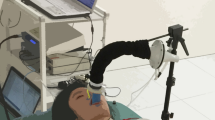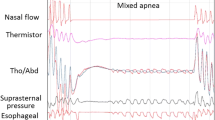Abstract
Ventilatory inductive plethysmography allows noninvasive monitoring of patient ventilation. Patient movements unrelated to breathing introduce severe errors in ventilator inductive plethysmographic measurements and restrict its usefulness. The purpose of this research was to develop and test a microprocessor-based real-time digital signal processor that uses an adaptive filter to detect patient movements unrelated to breathing. The adaptive filter processor was tested for retrospective identification of artifacts in 20 male volunteers who performed the following specific movements between epochs of quiet, supine breathing: raising arms and legs (slowly, quickly, once, and several times), sitting up, breathing deeply and rapidly, and rolling from a supine to a lateral decubitis position. Flow was simultaneously measured directly with a pneumotachograph attached to a mouthpiece. A multilinear regression was used to continuously calculate the calibration constants that relate the pneumotachographic and ventilatory inductive plethysmographic signals. Ventilatory inductive plethysmographic data were then processed, and results scored. There were a total of 166 movements. The calibration coefficients changed dramatically in 146 (88%) of the 166 movements. These movements would have significant errors on ventilatory inductive plethysmographic flow calculation. The changes lasted for the duration of the movements and returned to baseline within two to three breaths. The changes in the coefficients were five or more times larger than the variability around baseline during quiet, supine breathing. All of the total body movements and changes in breathing patterns were detected accurately. The filter detected 46 of 53 upper body movements, 34 of 36 lower body movements, 38 of 38 total body movements, and 19 of 19 breathing pattern changes where the calibration changed. The filter was able to detect 94% of the total 146 movements. These results could help improve the effectiveness of ventilatory inductive plethysmography as an apnea monitor for use in patients receiving epidural narcotics. More accurate respiratory assessments could also be made during sleep studies, pulmonary evaluations, or exercise evaluations.
Similar content being viewed by others
References
Rodenstein DO, Mercenier C, Stanescu DC. Influence of the respiratory route on the resting breathing pattern in humans Am Rev Respir Dis 1985;131:163–166
Gilbert R, Auchincloss JH, Brodsky J, Boden W. Changes in tidal volume, frequency and ventilation induced by their measurement. J Appl Physiol 1972;33:252–254
Askanazi J, Silverberg PA, Foster RJ, et al. Effects of respiratory apparatus on breathing pattern. J Appl Physiol 1980;48:577–580
Hisch JA, Bischop B. Human breathing patterns on mouth piece or face mask during air, CO2 or low O2. J Appl Physiol 1982;53:1281–1290
Douglas NJ, White DP, Weil JV, Zwillich CW. Effect of breathing route on ventilation and ventilatory drive. Respir Physiol 1983;51:209–218
Dolfin T, Duffty P, Wilkes D, et al. Effects of a face mask and pneumotachograph on breathing in sleeping infants. Am Rev Respir Dis 1983;128:977–979
Zimmerman PV, Connelan SJ, Middleton MV, et al. Postural changes in rib cage and abdominal volume-motion coefficients and their effect on the calibration of a respiratory inductance plethysmograph. Am Rev Respir Dis 1983;127:209–214
Watson H. The technology of respiratory inductance plethysmography. In: Stott FD, Rafferty EB, Goulding L, eds. ISAM 1979 proceedings of Third International Symposium on Ambulatory Monitoring. London: Academic Press, 1980:537–558
Sackner JD, Nixon AJ, Davis B, et al. Non-invasive measurement of ventilation during exercise using a respiratory inductive plethysmograph. Am Rev Respir Dis 1980;122:867–871
Cohn MA, Watson H, Weisshaut R, et al. A transducer for non-invasive monitoring of respiration. In: Stott FD, Rafferty EB, Sleigh P, Goulding L, eds. ISAM 1977 proceedings of the Second International Symposium on Ambulatory Monitoring. London: Academic Press, 1978:119–128
Cohn MA, Rao ASV, Broudy M, et al. The respiratory inductive plethysmograph: a new non-invasive monitor of respiration. Bull Eur Physiopathol Respir 1982;18:643–658
Sackner MA. Monitoring of ventilation without a physical connection to the airway. In: Sackner MA, ed. Diagnostic techniques in pulmonary disease, vol. 16. New York: Dekker, 1980:526–532
Chadha TS, Watson H, Birch S, et al. Validation of respiratory inductive plethysmography using different calibration procedures. Am Rev Respir Dis 1982;125:644–649
Loveridge B, West P, Anthonisen NR, Kryger MH. Single-position calibration of the respiratory inductance plethysmograph. J Appl Physiol 1983;55:1031–1034
Stagg D, Goldman M, Newsome-Davis J. Computer aided measurement of breath volume and time components using magnetometers. J Appl Physiol 1978;44:623–633
Dolfin T, Duffty P, Wilkes DL, et al. Calibration of respiratory induction plethysmography (Respitrace) in infants. Am Rev Respir Dis 1982;126:577–579
Widrow B, Stearns SD. Adaptive signal processing. Englewood Cliffs, NJ: Prentice-Hall, 1985
Tobin MJ, Chadha TS, Jenouri SJ, et al. Breathing patterns. 1. Normal subjects. Chest 1983;84:202–205
Tobin MJ, Chadha TS, Jenouri SJ, et al. Breathing patterns. 2. Diseased subjects. Chest 1983;84:286–294
Tabachnik E, Muller N, Toye B, et al. Measurement of ventilation in children using the respiratory inductive plethysmograph. J Pediatr 1981;99(6):895–899
Hersh EV, DEsjardins PJ, Simpser M, Dadzie C. Measurement of meperidine-induced respiratory depression using a new non-invasive technique. Anesth Prog 1985;Sept/Oct:194–198
Cousins MJ, Mather LE. Intrathecal and epidural administration of opioids. Anesthesiology 1984;61:276–310
Konno K, Mead J. Measurement of the separate volume changes of rib cage and abdomen during breathing. J Appl Physiol 1967;22:407–422
Stradling JR, Chadwick GA, Quirk C, Phillips T. Respiratory inductance plethysmography: calibration techniques, their validation, and the effects of posture. Bull Eur Physiopathol Respir 1985;21:317–324
Author information
Authors and Affiliations
Additional information
This work was supported by a Biomedical Research Support Grant, #S07RR07092 from the National Institutes of Health.
Rights and permissions
About this article
Cite this article
East, K.A., East, T.D., John Mathews, V. et al. Computerized artifact detection for ventilatory inductance plethysmographic apnea monitors. J Clin Monitor Comput 5, 170–176 (1989). https://doi.org/10.1007/BF01627449
Received:
Revised:
Accepted:
Issue Date:
DOI: https://doi.org/10.1007/BF01627449




